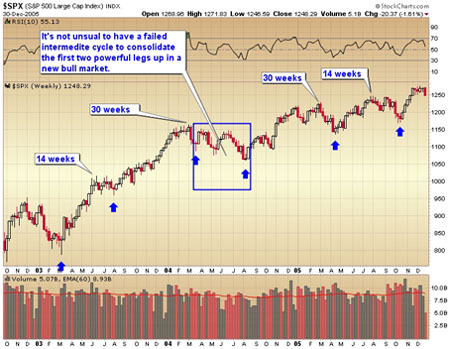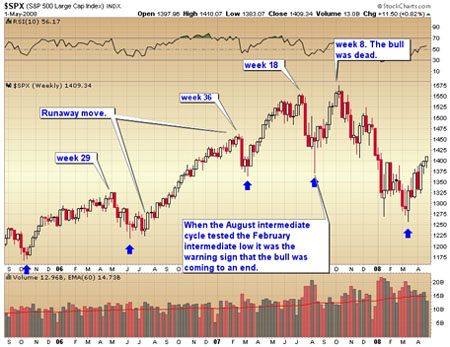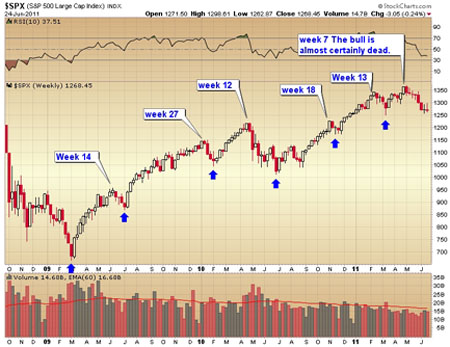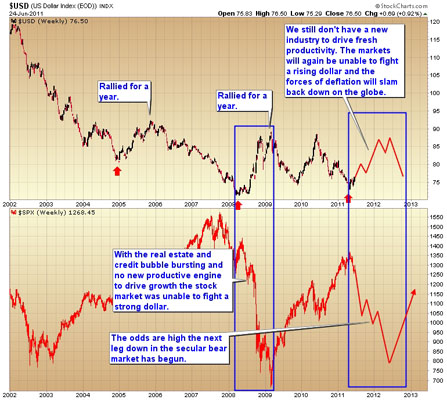First, a little background information. I'm going to be discussing almost exclusively the intermediate degree cycle. Now to start let me correct some misconceptions. Cycles are virtually worthless for timing tops. Cycles are measured from trough to trough. All we can really do with cycle theory is develop timing bands for bottoms, tops can occur at any time.
Next, I want to go over the concept of left- and right-translated cycles, as it is pertinent to what is happening in the stock market.
Now in order to understand how a cycle is translated you first have to determine the average duration of the cycle. In our case, we are going to focus on the intermediate degree cycle in the stock market. That cycle averages 20–25 weeks trough to trough. The median being 22 weeks. If we divide 22 weeks by 2 we come up with 11 weeks. That is an important number. It is the dividing line between a left-translated cycle and a right-translated cycle.
Any cycle that tops on week 12 or later constitutes a right-translated cycle. Right-translated cycles are the hallmark of bull markets. Let me explain.
In a healthy bull market, an intermediate degree correction is a profit-taking event and that's all it is. The media will find some scary reason for why the market is correcting but the real truth is that the market has just rallied long enough and far enough and is due a corrective move to consolidate the gains. There is one exception, which I will go over in a minute. Healthy bull markets are composed of multiple right-translated intermediate cycles.
Left-translated cycles, on the other hand, are the hallmark of markets that are in trouble. A left-translated cycle is a sign that the fundamentals of the market are broken, or in the process of breaking. A left-translated cycle is not a profit-taking event. A left-translated cycle is a sign that institutional money is selling into the rally.
Next, I'm going to show you the 2002–2007 bull market. The intermediate cycle troughs are marked with blue arrows. In the chart below, you can clearly see that every intermediate cycle—with one exception—rallied more than 12 weeks. This is a sign of a healthy bull market. The rallies are moving to new highs. When the intermediate rallies mature, they top late in the cycle followed by a profit-taking event that holds well above the prior intermediate trough. (The one exception, and I have marked it with the blue box, is that sometimes an intermediate cycle will top in a left-translated manner and make a lower low after the second leg up in a new bull market. This is just a sign of a market that needs to consolidate a huge move out of a bear market bottom.)

Next, let's move into the latter stages of the 2002–2007 bull market.

Again, we see the familiar pattern of higher highs, higher lows and intermediate cycles that are topping deep into their intermediate cycles. However, in the summer of '07 something happened that was a glaring warning sign that the cyclical bull market was in trouble. And that sign; the summer intermediate cycle dropped all the way down to test the prior cycle low in February. In a healthy bull market, that should not happen. As you recall, this was right about the time subprime mortgages began imploding. Smart money could read the writing on the wall and began exiting the market. The deathblow came when the next intermediate cycle topped in an extreme left-translated manner on week eight. That was the warning sign that institutional buyers had left the market. At that point, the bull had officially died.
Now let's look at the current bull market. . .

Up until last summer, this was a healthy bull market. The intermediate cycles were all right translated and we were making higher highs and higher lows. Last summer, that started to change. To begin with, the intermediate cycle topped on week 12, right on the dividing line of right and left translation. The market had managed to rally 16%. Time wise an intermediate decline was early but, in magnitude, a 16% rally is enough to trigger a profit-taking event. But this didn't turn into a normal profit-taking event. The decline moved below the February intermediate cycle low. Bernanke heard the alarm bells that started to ring; thus, began QE2 and the markets pulled back from the brink—temporarily.
I don't think anyone is under any delusions about what has powered this bull market and propped up a deeply flawed economy. Trillions and trillions of freshly printed dollars that's what. But that is now ending. Does anyone really believe the economy or stock market can continue to levitate without a constant flood of liquidity? If you do, I have some beachfront property I want to sell you in Las Vegas.
The market doesn't believe either! We now have an extreme left-translated intermediate cycle in progress that topped on week eight. Notice how the rally out of the March bottom was only able to make marginal new highs with absolutely no follow through—a sign that institutional traders sold into the breakout. Now, we have a market that's on the verge of penetrating a prior intermediate cycle low.
If the March low gets breached, we'll have the first confirmation that a new bear market has begun. The second confirmation will come if both the industrials and transports close below the March lows. That would constitute a Dow Theory sell signal. The last confirmation will come when the 50-day moving average moves below the 200-day moving average and the 200-day moving average turns down.
Next, I want to look at the dollar. In a deflationary environment, the value of currency rises. As many of you know, I've been predicting a major three-year cycle low in the dollar by the spring or early summer this year. It came during the first week of May.
These major cycle bottoms tend to produce very powerful rallies, often lasting up to a year. Now, if we were just coming out of recession and productivity was increasing, or we had a new industry that was creating massive job growth, then, yes, I would expect the market to be able to resist a rising dollar. Actually, in that scenario a rising dollar is signaling a healthy economy.
In our current environment, however, a rising dollar signals deflation! You can see that during the rally out of the '08 three-year cycle low the stock market came under severe pressure. I think it's safe to say the same thing will happen this time as the dollar rallies. Unfortunately, we don't have a new industry to drive job growth, power a sustainable economy and/or allow the markets to resist a rising dollar. All we have is commodity inflation created by the Fed in a vain attempt to print prosperity.

I've been warning for months that once the dollar bottomed and started to rally it would signal the end of the bull market and the start of the third leg down in the secular bear market. At this point, I think the only hope the bulls have is for Bernanke to turn the USD back down into an extreme left-translated three-year cycle. Unfortunately, he's decided to turn off the money spigot (don't worry he'll be turning it back on soon; though, by then, it will be too late).
Let us all hope that Bernanke has at least some modicum of common sense left. To turn the dollar back down into a left-translated three-year cycle this early will almost certainly destroy the currency by 2014. Not to mention the dollar will lose reserve currency status. Actually, that is my next big macro prediction. By 2014, the dollar's next three-year cycle low, Bernanke will have wrecked the currency and the dollar will no longer be the world's reserve currency.
So far, this bear market is progressing as expected. It started with the tech bubble bursting that transformed into a financial crisis and now has infected sovereign debt. Ultimately, it'll end in a massive currency crisis.
With QE2 ending next week, I think we are about to enter a very volatile and critical period in all asset markets. For the next three days, I'm going to offer everyone a $5 trial subscription. You will have complete access to the premium website during the trial period, which will include the weekend report with my view of where I think we are headed over the next month along with complete archives back to the beginning of the year and the terminology document, COT spreadsheets and cycle count charts. If during the trial period, you decide the newsletter is not for you just cancel following the directions on the homepage. Your trial subscription will remain active for three days. If you decide you'd like to continue receiving the SMT premium newsletter your trial subscription will automatically convert to a $25 monthly subscription at the end of the third day.
If you like the newsletter, you can also cancel the trial subscription and convert to a more cost-effective biannual or yearly subscription. The directions for converting to a more cost-effective subscription are also on the homepage. (The 15-month special will remain open until Monday evening.) To sign up for the trial click here. Click on the subscribe link on the right-hand side of the homepage. On the subscriptions options page, check the $5 special and follow the checkout instructions.
Toby Connor
Gold Scents



























































